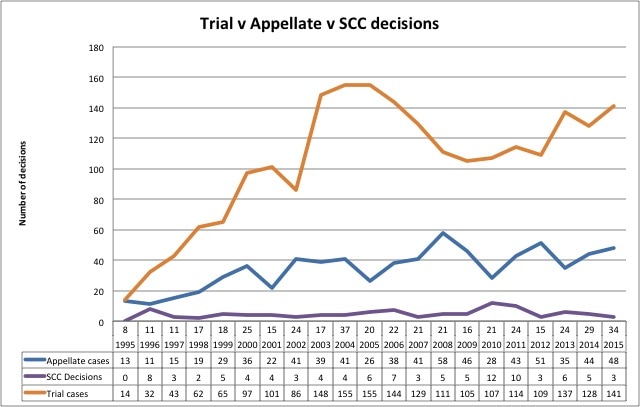
So, I ‘ve been playing with data. I’m going to write a few posts on some of the interesting things you can find by playing with data. I’ll start with this picture:
The graphic displays the total number of decisions from Canadian courts and tribunals on selected aboriginal rights cases. I got this data off Canlii, and cleaned it in Microsoft Excel. I won’t go in-depth on the search logic I used, but I made best efforts to capture two classes of cases: those involving collective rights holders and those involving aboriginal or treaty rights. The data one can draw from CANLII can be pretty cool, the CANLII/Excel combination allows users to take a look at any number of interesting phenomena in aboriginal rights law. Here, I am focusing on a year by year comparison. Since CANLII provides data on date of decision, one could look at the year of decision (which I do here), the month, the date or even the day of the week!
I make no guarantees on the efficacy of my data cleaning (I did do this for fun), but I think the data on this set (judicial decisions from 1995 to 2015) reveal several interesting points about aboriginal rights law in Canada. As a hint for what’s upcoming, these kinds of analytics can reveal the most cited aboriginal rights opinion (in CANLII’s opinion anyways) during that same period.
In this post, I just want to make some introductory comments about what I see in this data, but also to make a broader point on the value of using ‘analytics’ to look at trends in law, and particularly aboriginal rights law, more broadly. If nothing else, I can confirm that using CANLII’s data to analyze decisions provides excellent fodder for dinner parties and small talk with aboriginal rights lawyers (and who wouldn’t want to engage in witty banter with aboriginal rights lawyers?).
Looking at the number of decisions per year over the past 20 years reveals some results which should not be surprising. If you look at the ‘peaks’ and ‘valleys’ in trial decisions, it shouldn’t surprise you to see similar ‘peaks’ and ‘valleys’ in appellate decisions or in Supreme Court decisions, some number of years later.
It makes sense that if there are an unusually high number of trial decisions in a given year, that there would be an unusually high number of appeals filed and ultimately decided. Since I’m told appellate litigation doesn’t occur at lightning speed (it feels like it to me sometimes), its natural to see a bit of a lag in appellate decisions vis a vis trial decisions.
I would issue a caution about reading too much into the apparent buildup in litigation pre-2001 because it appears to me that CANLII doesn’t contain information on pre-2001 cases in several of its databases – this is likely more the effect of the digitization of trial and appellate decisions, than an actual litigation trend.
However, something that is interesting is the peak and subsequent decline in trial decisions post-2005. I would attribute this to the impact of the Supreme Court of Canada’s trilogy of decisions on the duty to consult and accommodate in 2004-05 (Haida/Taku/Mikisew). I find this a pretty important finding because what the Supreme Court did in those cases was to articulate what is essentially an interim remedy in otherwise extremely lengthy aboriginal rights cases. The prospect of a clearly articulated remedy, even one likely construed as a weak remedy by aboriginal rights claimants (winning a duty to consult case can seem like a far cry from an award of aboriginal title for some), provided guidance to both the Crown and industry proponents.
I would speculate that the prospect of a remedy, combined with considerable uncertainty about ‘how to implement’ the duty to consult and accommodate, led to a period where both the Crown and proponents concluded that it would be substantially less risky to litigate or otherwise ignore aboriginal rights or treaty rights claims, and to negotiate directly with collective rights holders.
If I’m right, then I’m inviting you to draw a somewhat counterintuitive conclusion: that recognition of rights and articulation of clear remedies may actually reduce the amount of litigation in aboriginal rights law. This conclusion, which I don’t think would be counterintuitive in other areas of law, nonetheless runs against a lot of conventional wisdom in aboriginal rigths law: that aboriginal rights themselves ‘create’ considerable uncertainty for the Crown and for industry.
I’m not sure I’d go so far as to draw a rock-solid conclusion off this particular picture. I would; however, suggest that greater use of analytics by rights-holders, by industry and by the academy invite a richer discourse on the nature of aboriginal rights law than speculation of what a judgement ‘might’ or ‘might not’ do as its implemented.
 RSS Feed
RSS Feed